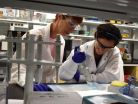Protein suggests a new strategy to thwart infection
2015-07-06
(Press-News.org) MADISON - The newfound ability of a protein of the intestines and lungs to distinguish between human cells and the cells of bacterial invaders could underpin new strategies to fight infections.
Writing this week (July 6, 2015) in the journal Nature Structural and Molecular Biology, a team led by University of Wisconsin-Madison Professor Laura Kiessling describes the knack of a human protein known as intelectin to distinguish between our cells and those of the disease-causing microbes that invade our bodies.
"This has the potential to change the game in terms of how we combat microbes," says Kiessling.
The discovery by Kiessling and several collaborating groups also helps illuminate a previously unrecognized line of defense against microbial invaders. In addition to Kiessling's lab, groups in the labs of UW-Madison bacteriology Professor Katrina Forest, Scripps Research Institute cell and molecular biology Professor James Paulson, and Emory University biochemistry Professor Richard Cummings contributed to the study.
Intelectin is not new to science, Kiessling notes, but its ability to selectively identify many different kinds of pathogens and distinguish those cells from human cells was unknown.
"The protein is upregulated with infection," explains Kiessling, "and while no one has yet shown that it is an antimicrobial protein, there are multiple lines of evidence that suggest it is."
TheWisconsin group established that intelectin has all the properties needed to function in the immune system's surveillance complex. That makes sense, Kiessling explains, as the protein is found mostly in the cells in the intestine and respiratory system, the places most likely to be entry points for microbial pathogens.
Intelectin performs its surveillance role through its ability to selectively recognize the carbohydrate molecules that reside on the surface of cells. Both mammalian cells and microbial cells have carbohydrates known as glycans on their cell surfaces. However, the chemical structures of the glycan molecules vary, and the molecules that decorate the surface of human cells are markedly different from those on microbial cells.
By exposing human intelectin to arrays of both human and microbial glycanS, Kiessling and her colleagues found that intelectin could recognize different kinds of microbes as well as distinguish between microbial and mammalian glycans.
The role of intelectin in immune response, Kiessling believes, is likely ancient. The same kinds of proteins are found in many different kinds of animals, including sheep, mice frogs, eels, fish and even sea squirts, suggesting it has been conserved through evolutionary history.
The glycans to which intelectin attaches, however, can be vastly different. In humans, for example, less than 35 chemical building blocks are used to make the cell surface molecules. In bacteria, nature deploys more than 700 chemical building blocks to make glycans. This immense increase in diversity can make accurate detection difficult.
"Human intelectin just recognizes a small portion of the glycan, a shared feature like a handle," explains Kiessling. "Then it can recognize when the handles appear, even when different types of bacteria make different glycans."
The larger insight from the study could aid in the design of the next generation of antibiotics, which are urgently needed as many pathogens have become resistant to the antibiotics now most commonly used to treat infection.
INFORMATION:
The discovery has been disclosed to the Wisconsin Alumni Research Foundation, a private, not-for-profit organization that manages intellectual property on behalf of UW-Madison.
The new Wisconsin study, which was led by UW-Madison biochemistry graduate student Darryl Wesener, was supported by the National Institutes of Health. Kiessling is the Steenbock Professor of Chemistry and the Laurens Anderson Professor of Biochemistry.
-- Terry Devitt (608) 262-8282, trdevitt@wisc.edu
ELSE PRESS RELEASES FROM THIS DATE:
2015-07-06
Studying brain scans and cerebrospinal fluid of healthy adults, scientists have shown that changes in key biomarkers of Alzheimer's disease during midlife may help identify those who will develop dementia years later, according to new research.
The study, at Washington University School of Medicine in St. Louis, is published July 6 in JAMA Neurology.
"It's too early to use these biomarkers to definitively predict whether individual patients will develop Alzheimer's disease, but we're working toward that goal," said senior author Anne Fagan, PhD, a professor of neurology. ...
2015-07-06
A blood-borne molecule that increases in abundance as we age blocks regeneration of brain cells and promotes cognitive decline, suggests a new study by researchers at UC San Francisco and Stanford School of Medicine.
The molecule in question, known as beta-2 microglobulin, or B2M, is a component of a larger molecule called MHC I (major histocompatibility complex class I), which plays a major role in the adaptive immune system. A growing body of research indicates that the B2M-MHC I complex, which is present in all cells in the body except red blood cells and plasma cells, ...
2015-07-06
What gives plastic objects their flexibility and reduces their brittleness is the concentration of plasticiser. For example, a chemical solvent of the phthalate family called DOP is often used. The trouble is there are concerns that phthalates present health risks. So there is a demand for more alternatives. Now, scientists from China have examined the effect of using DEHHP, a new eco-friendly plasticiser, used in combination with PVC. For a plasticiser to work, there has to be adequate hydrogen bonding with the plastic. By combining experiments and simulations, the team ...
2015-07-06
Nearly 800 million people worldwide don't have access to safe drinking water, and some 2.5 billion people live in precariously unsanitary conditions, according to the Centers for Disease Control and Prevention. Together, unsafe drinking water and the inadequate supply of water for hygiene purposes contribute to almost 90% of all deaths from diarrheal diseases -- and effective water sanitation interventions are still challenging scientists and engineers.
A new study published in Nature Nanotechnology proposes a novel nanotechnology-based strategy to improve water filtration. ...
2015-07-06
Optogenetics techniques, which allow scientists to map and control nerve cells using light stimulation, are being used to study neural circuits in the brain with unprecedented precision. This revolutionary technology relies on light-sensitive proteins such as channelrhodopsins, and researchers at UC Santa Cruz have now determined the molecular mechanism involved in the light-induced activation of one of these proteins.
The new findings, published July 3 in two papers in the Journal of Biological Chemistry, can help scientists create tailor-made proteins optimized for ...
2015-07-06
Evolutionary change in a gene resurrected in the lab from the extinct woolly mammoth altered the gene's temperature sensitivity and likely was part of a suite of adaptations that allowed the mammoth to survive in harsh arctic environments, according to new research. In a study published in Cell Reports on July 2, 2015, researchers determined the whole-genome sequence of two woolly mammoths and three modern Asian elephants, predicted the function of genetic changes found only in the mammoths, and then experimentally validated the function of a woolly mammoth gene reconstructed ...
2015-07-06
An international team, led by a University of Adelaide genetics expert, has made a breakthrough discovery which is expected to help thousands of young girls worldwide who are suffering from a rare yet debilitating form of epilepsy.
Professor Jozef Gecz, from the University of Adelaide's Robinson Research Institute, was a key player in identifying the responsible gene and mutations in this female-only epileptic syndrome, in 2008.
In breakthrough research published in Oxford Journals, Human Molecular Genetics, Professor Gecz has now found a treatment for this disorder. ...
2015-07-06
(PHILADELPHIA) -- Transfer RNAs (tRNAs) are ancient molecules and indispensable components of all living cells - they are found in all three kingdoms of life i.e., in archaea, bacteria and eukaryotes. In a cell, they are part of the machinery that translates messenger RNA (mRNA) sequences into amino acid sequences.
In recent years advances in sequencing technology have enabled detailed investigations of the RNA molecules that are active in a cell. A study published July 6th in the journal Oncotarget reports on a newly discovered category of tRNA fragments as well as ...
2015-07-06
Andrew Hicks from the Museum of Natural History at the University of Colorado and his team discovered a previously unknown leafhopper species in the New Jersey Pine Barrens, located just east of the megalopolis that extends from New York City to Washington, DC. This was the first time an insect has been reported from the state-listed threatened pinebarren smokegrass, Muhlenbergia torreyana. The study can be found in the open-access journal ZooKeys.
The discovery was made with the help of Dr. Gerry Moore of the Natural Resources Conservation Service in Greensboro, NC, ...
2015-07-06
Young children, who possess a good understanding of their own emotions and of those of their fellow human beings early on, suffer fewer attention problems than their peers with a lower emotional understanding. Evidence of this phenomenon was found through a study of Leuphana University of Lueneburg and George Mason University, USA, under the auspices of Prof. Dr. Maria von Salisch, Professor of Developmental Psychology at Leuphana University of Lueneburg. The study was recently published in the journal Kindheit & Entwicklung (Childhood & Development).
The findings stem ...
LAST 30 PRESS RELEASES:
[Press-News.org] Protein suggests a new strategy to thwart infection


